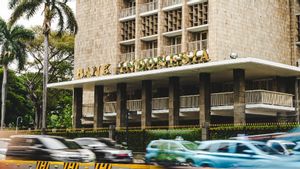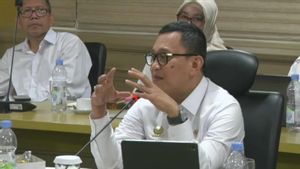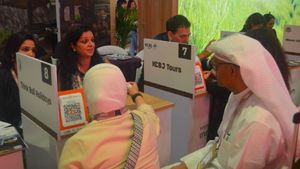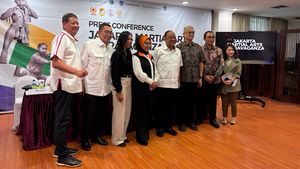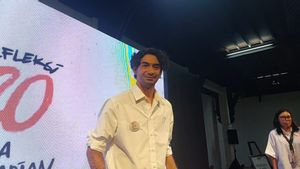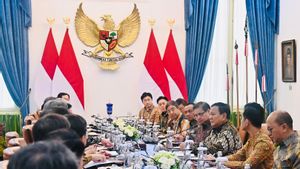JAKARTA - Today is celebrated as Transmigration Service Day. One of the important goals of holding this program is in the framework of national development. How has it been successful since the first transmigration program was launched?
The implementation of transmigration was first carried out after Indonesian independence, today, December 12, 1950. Therefore, today is celebrated as the Day of Bhakti Transmigration (HBT).
The implementation of the transmigration program according to the Ministry of Villages, Development of Disadvantaged Regions and Transmigration of the Republic of Indonesia in the Transmigration of the Doeloe Period, Now and Future Hope (2015) is basically equalization in various aspects of development.
The development is aimed at various fields, such as education, health, mental spiritual / religious, sports, arts and others.
"Transmigration has a very important role for national development and transmigrants as the object of organizing transmigration have contributed to regional development," he wrote.
However, the challenge of transmigration at this time is not only equal distribution of population, but also an integral part of regional development. Its implementation is also adjusted to the characteristics and specific conditions of the region.
Transmigration also demands increased cooperation and harmonization between the central and regional governments in terms of policy planning and regional development strategies for transmigration. Apart from that, the synergy must also link the top government leaders at the center to the lowest in the regions - customary leaders and community leaders - for the purposes of provision and land ownership status.
In line with changes in the strategic environment in Indonesia, transmigration was carried out with the following objectives:
1. Improve the welfare of transmigrants and the surrounding community.
2. Increasing and equitable regional development.
3. Strengthening the unity and integrity of the nation.
As reported by the kemenkeu.go.id site, the first transmigration office sent 25 families (KK) or a total of 98 people. The initial location at that time was in Lampung as many as 23 families and to Lubuk Linggau 2 families.
The term transmigration was first put forward by President Sukarno in 1927 in the Soeloeh Indonesia Daily. Then at the Economic Conference in Kaliurang, Yogyakarta, February 3, 1946, Vice President Hatta mentioned the importance of transmigration to support the development of industrialization outside Java.
The transmigration program which was held in 1950 actually continued the program that had been initiated by the Dutch colonial government in 1905. At that time the Dutch government called it colonization.
As written by the Ministry of Villages, Development of Disadvantaged Areas and Transmigration of the Republic of Indonesia in the Transmigration of the Doeloe, Present and Future (2015) period, it was explained that the first colonisatie or transmigration program was held for 155 families from Bagelan, Karesidenan Kedu. They were sent to Gedongtataan, Lampung.
Subsequently, in 1912, a resettlement was opened near Kota Agung. Until the 1930s, efforts to initiate a move sponsored by the Dutch Government continued.
Most of the transmigrant families worked in the plantation sector. Until the 1940s, approximately 200,000 residents had been moved with the help of the Dutch government as one of the colonization policies. The program was stopped when Japan controlled Indonesia in 1942. However, after independence, the government resumed the program as previously explained.
Many failures
Initially, President Sukarno had big ambitions in this program. As explained by Rohani Budi Prihatin in his writing "Revitalization of the Transmigration Program" published by the Aspiration Journal (2013) in 1947, Sukarno had a target to move 31 million people within 35 years.
In 1951 that target was added to 49 million people. However, due to political and economic turmoil at that time, the transmigration program "was not possible at that time," wrote Rohani.
The failure of the transmigration program in the 1950s finally awakened the government to making more realistic targets. In 1961-1969, the government only set a target of 1.56 million people.
In fact, even that target was not met because the total number of transmigrants during that period was only 174,000 people. Still according to Rohani, this achievement was arguably a failure. "If measured with quantitative parameters, the transmigration program between 1950-1960s can be categorized as a failure," he said.
Continue
Although the transmigration program failed many times in the Sukarno government, the New Order regime continued the program in the First Five-Year Development Plan (Repelita I). During the New Order era, the transmigration program seemed to focus more on developing areas outside Java than reducing population density on the island of Java.
The transmigration program continues and continues to adapt to all its challenges. Apart from being related to political developments such as regional autonomy, challenges also arise in line with the development of our country which is hit by the economic crisis. When the economic crisis hit during the transition from the New Order to the Reformation Order, the transmigration program also stalled.
Various economic, social and political upheavals made the transmigration program seem to have been sidelined. Yes, although in the end it is still maintained and continues to this day. However, the transmigration program has recently developed a paradigm.
In fact, initially transmigration only focused on equal distribution of population, became an integral part of regional development, and its implementation was adjusted to the characteristics and specific conditions of the region, and required the implementation of transmigration to have a more cultural insight and local wisdom.

Today's transmigration is contained in the target of the 2015-2019 National Mid-Term Development Plan, the government has determined 144 transmigration areas, which are focused on 72 residential units (SP) and 20 new urban areas (KPB).
According to the Minister for Rural Development, Disadvantaged Regions and Transmigration, Eko Putro Sandjojo, during the last administration, the challenges of transmigration are different now. There is a new problem running this program.
"It turns out that newcomers or transmigrants grow faster than local communities. Finally, local people are left behind. Well, we don't want that to happen because it can create social inequalities," said Minister Eko in Jakarta, October 25, 2018 as quoted by katadata.co.id.
To anticipate this, the Ministry of Health has revitalized the transmigration area. The entire transmigration area and its surroundings must both grow and prosper. This is done, among others, by developing Superior Products for Rural Areas (Prukades).
Minister Eko asked every village, including the transmigration area, to propose a minimum of three superior products to be developed in that area. The residents' interest in joining this program is quite a lot. However, so many people who registered had to queue, especially enthusiasts from Central Java, West Java and East Java.
Residents who participate in the transmigration program will be provided with facilities in the form of residential houses, two hectares of land, and post-harvest facilities. Although the transmigration program at the beginning had encountered many failures, and had many obstacles in running it, the program, which has been implemented since the 1950s, has succeeded in stimulating economic growth outside Java.
As of 2018, according to data from the Ministry of Health, this program has succeeded in building 1,183 definitive villages outside Java, 385 sub-districts, 104 cities / regencies, 48 independent integrated cities, and two provincial capitals. The provinces of West Sulawesi and North Kalimantan are examples of successful transmigration, because these two provinces were born from the program.
The English, Chinese, Japanese, Arabic, and French versions are automatically generated by the AI. So there may still be inaccuracies in translating, please always see Indonesian as our main language. (system supported by DigitalSiber.id)



